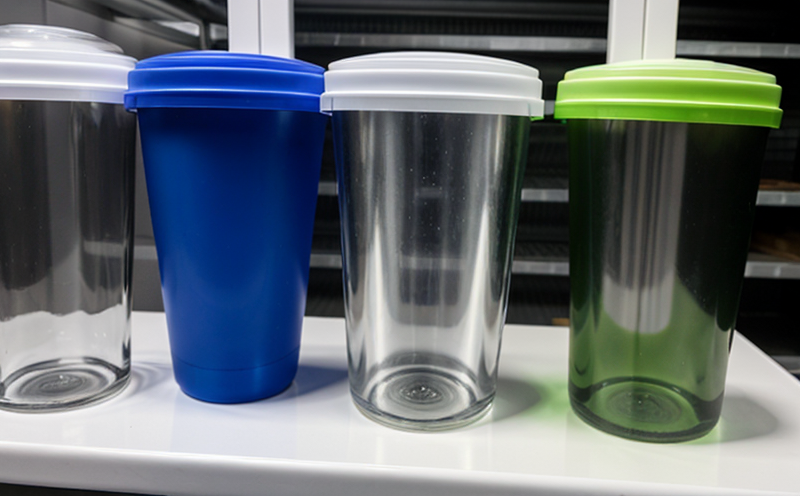ISO 4802-3 Glass Breakage Under Load
The ISO 4802-3 standard specifies the method for determining the resistance of glass containers to breakage under load. This test is crucial in ensuring that glass packaging meets quality and safety standards, particularly when subjected to mechanical stress during handling or transport.
Quality managers and compliance officers rely on this test to ensure their products meet international standards. It helps R&D engineers refine product designs and supports procurement teams by verifying the integrity of supplier materials. The ISO 4802-3 standard is part of a series that addresses various aspects of glass container testing, with each part focusing on different methodologies or specific applications.
The test involves subjecting a cylindrical specimen to progressively increasing loads until breakage occurs. This allows for the determination of the maximum load at which the specimen fails. The results are compared against established criteria to assess whether the material and design meet the required standards.
Proper testing is essential in industries such as pharmaceuticals, food & beverage, and chemicals where glass packaging plays a critical role in protecting product quality and safety. Failure to adhere to these standards can lead to product contamination or damage during transit, resulting in costly recalls and reputational damage.
The ISO 4802-3 test is particularly relevant for containers used in environments with high pressure differentials, such as vacuum packaging. Understanding the breaking point under load helps manufacturers design more robust packaging that can withstand the rigors of modern distribution channels.
Testing according to this standard ensures not only compliance but also enhances product reliability and safety. It allows companies to demonstrate a commitment to quality control and consumer protection, which is increasingly important in today's competitive market.
Scope and Methodology
| Test Parameter | Description |
|---|---|
| Test Specimen | A cylindrical glass container with uniform wall thickness, typically 10 mm in diameter. |
| Loading Mechanism | The specimen is placed on a flat surface and subjected to gradually increasing axial loads using a hydraulic press. |
| Load Increment | The load is increased by 50 N increments until breakage occurs or the maximum specified load of 1,200 N is reached. |
| Measurement | The axial force and deflection are monitored continuously during loading. |
| Acceptance Criteria | The specimen should not break at a load less than the minimum specified in the standard. |
This table outlines key parameters involved in conducting an ISO 4802-3 test. The loading mechanism and measurement process are critical for accurate results, as they provide insights into how the glass behaves under stress. Compliance with these criteria ensures that the test accurately reflects real-world conditions, making it a reliable indicator of packaging integrity.
Why Choose This Test
The ISO 4802-3 glass breakage under load test is essential for several reasons:
- Ensures Quality Compliance: It guarantees that the packaging meets international standards, enhancing consumer trust and regulatory compliance.
- Risk Mitigation: By identifying potential weaknesses in design or material selection early on, companies can mitigate risks associated with product failure during transport or storage.
- Innovation Support: Engineers can use test results to refine designs, improving both the functionality and durability of glass packaging.
- Supplier Evaluation: This test helps procurement teams verify that suppliers meet quality expectations, ensuring a consistent supply chain.
The ISO 4802-3 standard is widely recognized for its rigorous approach to testing. It provides a standardized method for evaluating glass packaging under mechanical stress, which is invaluable in industries where product integrity and safety are paramount.
Environmental and Sustainability Contributions
- Eco-Friendly Packaging: By ensuring that glass packaging meets strict quality standards, this test promotes the use of eco-friendly materials. Glass can be recycled indefinitely without losing its properties.
- Reduced Waste: Properly designed and tested glass containers reduce the likelihood of breakage during transport or handling, minimizing waste generation.
- Energy Efficiency: The production process for glass is energy-intensive but efficient recycling can offset this. Testing ensures that recycled materials are suitable for packaging applications.
- Extended Shelf Life: Robust packaging extends the shelf life of products, reducing food spoilage and waste in distribution channels.
The ISO 4802-3 test contributes to environmental sustainability by promoting the use of high-quality glass containers that are durable and recyclable. By minimizing breakage during transport and handling, it also helps reduce carbon emissions associated with product recalls or reprocessing.





